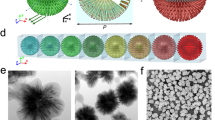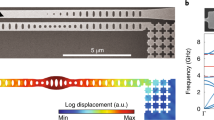Abstract
Light usually propagates inside transparent materials in well known ways1. However, recent research2,3,4,5,6 has examined the possibility of modifying the way the light travels by taking a normal transparent dielectric and inserting tiny metallic inclusions of various shapes and arrangements. As light passes through these structures, oscillating electric currents are set up that generate electromagnetic field moments; these can lead to dramatic effects on the light propagation, such as negative refraction. Possible applications include lenses that break traditional diffraction limits3,4 and ‘invisibility cloaks’ (refs 5, 6). Significantly less research has focused on the potential of such structures for slowing, trapping and releasing light signals. Here we demonstrate theoretically that an axially varying heterostructure with a metamaterial core of negative refractive index can be used to efficiently and coherently bring light to a complete standstill. In contrast to previous approaches for decelerating and storing light7,8,9,10,11,12,13, the present scheme simultaneously allows for high in-coupling efficiencies and broadband, room-temperature operation. Surprisingly, our analysis reveals a critical point at which the effective thickness of the waveguide is reduced to zero, preventing the light wave from propagating further. At this point, the light ray is permanently trapped, its trajectory forming a double light-cone that we call an ‘optical clepsydra’. Each frequency component of the wave packet is stopped at a different guide thickness, leading to the spatial separation of its spectrum and the formation of a ‘trapped rainbow’. Our results bridge the gap between two important contemporary realms of science—metamaterials and slow light. Combined investigations may lead to applications in optical data processing and storage or the realization of quantum optical memories.
This is a preview of subscription content, access via your institution
Access options
Subscribe to this journal
Receive 51 print issues and online access
$199.00 per year
only $3.90 per issue
Buy this article
- Purchase on Springer Link
- Instant access to full article PDF
Prices may be subject to local taxes which are calculated during checkout




Similar content being viewed by others
References
Born, M. & Wolf, E. Principles of Optics 6th edn (Pergamon, Oxford, 1980)
Grigorenko, A. N. et al. Nanofabricated media with negative permeability at visible frequencies. Nature 438, 335–338 (2005)
Pendry, J. B. Negative refraction makes a perfect lens. Phys. Rev. Lett. 85, 3966–3969 (2000)
Hou-Tong, C. et al. Active terahertz metamaterial devices. Nature 444, 597–600 (2006)
Pendry, J. B., Schurig, D. & Smith, D. R. Controlling electromagnetic fields. Science 312, 1780–1782 (2006)
Schurig, D. et al. Metamaterial electromagnetic cloak at microwave frequencies. Science 314, 977–980 (2006)
Liu, C., Dutton, Z., Behroozi, C. H. & Hau, L. V. Observation of coherent optical information storage in an atomic medium using halted light pulses. Nature 409, 490–493 (2001)
Gehrig, E., van der Poel, M., Mørk, J. & Hess, O. Dynamic spatiotemporal speed control of ultrashort pulses in quantum-dot SOAs. IEEE J. Quant. Electron. 42, 1047–1054 (2006)
Vlasov, Y. A., O’Boyle, M., Hamann, H. F. & McNab, S. J. Active control of slow light on a chip with photonic crystal waveguides. Nature 438, 65–69 (2005)
Bigelow, M. S., Lepeshkin, N. N. & Boyd, R. W. Superluminal and slow light propagation in a room-temperature solid. Science 301, 200–202 (2003)
Okawachi, Y. et al. Tunable all-optical delays via Brillouin slow light in an optical fiber. Phys. Rev. Lett. 94, 153902 (2005)
Stockman, M. I. Nanofocusing of optical energy in tapered plasmonic waveguides. Phys. Rev. Lett. 93, 137404 (2004)
Karalis, A., Lidorikis, E., Ibanescu, M., Joannopoulos, J. D. & Soljačić, M. Surface-plasmon-assisted guiding of broadband slow and subwavelength light in air. Phys. Rev. Lett. 95, 063901 (2005)
Blumenthal, D. J., Pruncal, P. R. & Sauer, J. R. Photonic packet switches: Architectures and experimental implementations. Proc. IEEE 82, 1650–1667 (1994)
Gersen, H. et al. Real-space observation of ultraslow light in photonic crystal waveguides. Phys. Rev. Lett. 94, 073903 (2005)
Vlasov, Y. A. & McNab, S. J. Coupling into the slow light mode in slab-type photonic crystal waveguides. Opt. Lett. 31, 50–52 (2006)
Pendry, J. B., Holden, A. J., Robbins, D. J. & Stewart, W. J. Magnetism from conductors and enhanced nonlinear phenomena. IEEE Trans. Microwave Theory Tech. 47, 2075–2084 (1999)
Shelby, R., Smith, D. R. & Schultz, S. Experimental verification of a negative index of refraction. Science 292, 77–79 (2001)
Cheianov, V. V., Fal'ko, V. & Altshuler, B. L. The focusing of electron flow and a Veselago lens in graphene p-n junctions. Science 315, 1252–1255 (2007)
Shalaev, V. M. Optical negative-index metamaterials. Nature Photonics 1, 41–48 (2007)
Alù, A. & Engheta, N. Three-dimensional nanotransmission lines at optical frequencies: A recipe for broadband negative-refraction optical metamaterials. Phys. Rev. B 75, 024304 (2007)
Berman, P. R. Goos-Hänchen shift in negatively refractive media. Phys. Rev. E 66, 067603 (2002)
Milonni, P. W. Fast Light, Slow Light and Left-Handed Light Chs 5 6 (Institute of Physics, Bristol, 2005)
Tsakmakidis, K. L., Klaedtke, A., Aryal, D. P., Jamois, C. & Hess, O. Single-mode operation in the slow-light regime using oscillatory waves in generalized left-handed heterostructures. Appl. Phys. Lett 89, 201103 (2006)
Snyder, A. & Love, J. D. Optical Waveguide Theory Chs 5 19 (Chapman and Hall, New York, 1983)
Tsakmakidis, K. L., Hermann, C., Klaedtke, A., Jamois, C. & Hess, O. Surface plasmon polaritons in generalized slab heterostructures with negative permittivity and permeability. Phys. Rev. B 73, 085104 (2006)
Boardman, A. D. & Marinov, K. Electromagnetic energy in a dispersive metamaterial. Phys. Rev. B 73, 165110 (2006)
Tamir, T. Integrated Optics Ch. 2 (Springer, New York, 1979)
Helszajn, J. Ridge Waveguides and Passive Microwave Components (IEE Press, London, 2000)
Povinelli, M. L. et al. Evanescent-wave bonding between optical waveguides. Opt. Lett. 30, 3042–3044 (2005)
Acknowledgements
We thank A. Klaedtke and D. P. Aryal for discussions and technical assistance. This work was supported by the Engineering and Physical Sciences Research Council (UK).
Author Contributions K.L.T. and O.H. conceived the presented idea. K.L.T. developed the theory, performed the computations and wrote a draft of the paper. A.D.B. contributed to the discussions. O.H. encouraged K.L.T. to investigate metamaterials and slow light and supervised the findings of the work.
Author information
Authors and Affiliations
Corresponding authors
Ethics declarations
Competing interests
The authors declare no competing financial interests.
Supplementary information
Supplementary Information
This file contains Supplementary Equations. Sections 1 and 3 of the document include the derivation of Eqs. (1)-(4) used in the main body of the Letter. Section 2 discusses the derivation of closed-form expressions for the distances xp12 and xp13 between the ray cross points and the 1-2 and 1-3 media interfaces, respectively. The fourth section contains analytic expressions for the calculation of the characteristic impedance in right- and left-handed waveguides. (PDF 400 kb)
Rights and permissions
About this article
Cite this article
Tsakmakidis, K., Boardman, A. & Hess, O. ‘Trapped rainbow’ storage of light in metamaterials. Nature 450, 397–401 (2007). https://doi.org/10.1038/nature06285
Received:
Accepted:
Published:
Issue Date:
DOI: https://doi.org/10.1038/nature06285
This article is cited by
-
Controlling water waves with artificial structures
Nature Reviews Physics (2024)
-
Pine-like elastic metamaterials for urban seismic Rayleigh wave attenuation
Urban Lifeline (2024)
-
Enhancing broadband vibration suppression of a cable conductor using graded metamaterials
Journal of the Brazilian Society of Mechanical Sciences and Engineering (2024)
-
Imaging-based intelligent spectrometer on a plasmonic rainbow chip
Nature Communications (2023)
-
Recent advances in metasurface design and quantum optics applications with machine learning, physics-informed neural networks, and topology optimization methods
Light: Science & Applications (2023)
Comments
By submitting a comment you agree to abide by our Terms and Community Guidelines. If you find something abusive or that does not comply with our terms or guidelines please flag it as inappropriate.



